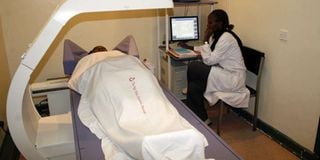Join me, nuclear medicine technologist challenges girls

Nuclear medicine technologist Ms Patricia Mbaabu attending to a patient at the Radiography department DXA bone density image scanner at Aga Khan Hospital.
What you need to know:
- Nuclear medicine technologist Ms Patricia Mbaabu says there is a shortage of nuclear medicine specialists in the country.
- Government putting up massive cyclotron at Kenyatta University Teaching, Referral and Research Hospital (KUTRRH).
- A cyclotron is a machine used to make short-lived radioactive isotopes that can be used for medical imaging or research.
- It takes training in nuclear medicine to run a PET scan, handle cyclotron and radioactive isotopes.
Girls in Kenya have been urged to study nuclear medicine to take advantage of the emerging opportunities in the medical sector.
Nuclear medicine technologist Ms Patricia Mbaabu noted shortage of the specialists in the country in a September 14, webinar on Young Women Scaling Heights in Nuclear Science organised by African Young Generation in Science.
“Nuclear medicine is actually picking up in Kenya. When I graduated, we only had Kenyatta National Hospital (KNH) and Aga Khan University Hospital (with cyclotron). But now we are having many opportunities. Aga Khan is developing very fast,” she said.
“And now the government is putting up a massive cyclotron at Kenyatta University Teaching, Referral and Research Hospital (KUTRRH) and we have been trying to look for Kenyans to run the centre and we couldn’t find people,” she added.
As defined by Provincial Health Services Authority, a publicly funded health service provider in the province of British Columbia, Canada; a cyclotron is a machine used to make short-lived radioactive isotopes that can be used for medical imaging or research.
East and Central Africa
In December 2017, Aga Khan University Hospital (AKUH) announced acquisition of ultra-modern Positron Emission Tomography (PET) CT scanner and cyclotron, a first in East and Central Africa.
At the time, chairperson of AKUH’s department of radiology, Prof. Sudhir Vinayak, explained a cyclotron as a compact particle accelerator that could produce small quantities of radioactive isotopes, a substance required for the PET imaging.”
He said the combined technology will change diagnostic medicine in the region as it could “enable doctors identify health threats at the cell-level thus giving them the best view and time of treatment for complex diseases such as cancer and heart diseases, brain and other central nervous system problems, thereby improving treatment outcomes.”
Ms Mbaabu said it takes training in nuclear medicine to run a PET scan, handle cyclotron and radioactive isotopes thus the need for more qualified professionals to meet the demand.
Stem disciplines
She said it is time for Kenyan universities to start training on nuclear medicine as none of the higher learning institutions offers the course.
Ms Mbaabu studied in South Africa for her degree in nuclear medicine. Morocco and Egypt are other countries currently offering the training.
Nuclear medicine is a field of study falling under Science, Technology, Engineering and Mathematics (STEM) disciplines where studies show women need financial and moral support to succeed.
A 2020 study by The African Academy of Sciences on Factors which Contribute to or Inhibit Women in Science, Technology, Engineering, and Mathematics in Africa found that for women to succeed in STEM, they require affirmative initiatives such as payment of fees alongside material support or encouragement from family members in STEM related fields.
In Africa, countries are encouraged to allocate one per cent of their gross domestic product (GDP) for research and development to enhance STEM innovations. This is an enticement provided for under the African Union’s Consolidated Plan of Action (CPA) on matters of science, technology and innovation (STI) to which the 55 member States ascribe to.
Female researchers
Globally, only 16 per cent of female students graduate from Science, Technology, Engineering and Mathematics (STEM) courses compared to 47 per cent for male, a 2016 Gender Gap Report by World Economic Forum (WEF) shows.
On average in 2015, women accounted for 30 per cent of researchers in the STEM disciplines in the sub-Saharan Africa, provides data from United Nations Educational, Scientific and Cultural Organization (Unesco).
There are, however, country variations on female representation. In Lesotho, for instance, the female researchers’ proportion dropped from 76 per cent to 31 per cent between 2002 and 2011.
While between 2011 and 2013, the representation increased in South Africa to 43.7 per cent, followed by Egypt at 42.8 per cent and Morocco with 30.2 per cent.





